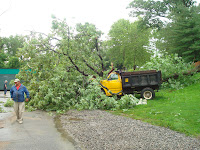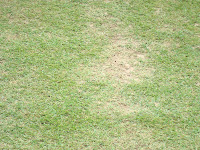We've purchased some heirloom tomatoes and peppers for Chef Rob to do some magic with. We are probably looking at August or so before they will be ready. The varieties listed below are what we have growing in the green house right now.
TomatoRiesentraube 80 days -Indeterminate. This old German heirloom was offered in Philadelphia by the mid-1800's. The sweet grape-shaped fruit grow to one ounce in large clusters on the plant. The name means "Giant Bunch of Grapes" in German. It is probably the most popular small tomato with seed collectors, as many enjoy the rich, full tomato flavor that is missing in today's cherry types. Large plants produce massive yields.
Anna Maria's Heart New $3.00 70-85 days -- --Indeterminate 6-10 ounce fruits of very good flavor. Some growers consider this variety superior to “Pink Oxheart.” (seed courtesy of Carolyn Male)
Costoluto Genovese $3.0078 days - Indeterminate. Deeply ribbed Italian heirloom with a rich, full flavor. Hearty plants that do well in hot weather, but will produce even when the weather cools down. Delicious flavor.
Ludmilla's Red Plum NEW $3.0070-85 days - Indeterminate. Outstanding producer. Very flavorful, 3 to 5 inch, plum-shaped fruits, weighing 6 to 10 ounces. The variety had been grown for over 50 years by one Ludmilla, a “Kazakstan German,” who gave seeds to Reinhard Kraft. (Seed courtesy of Carolyn Male)
Ingegnoli Gigante Liscio (Large Smooth Tomato) $3.0075 days - Indeterminate.Giant fruit are smooth and very tasty, having more vibrant tomato flavor than many huge tomatoes; perfect for home gardeners. This historic Italian heirloom was developed around 1900 from varieties 'Ponderosa' and 'Saint Louis'. It is nearly extinct in the United States. Few seeds. Mid season. Said to be of American origin. Perhaps brought back to Italy by emigrants who returned home.
Riesentraube $3.0080 days -Indeterminate. This old German heirloom was offered in Philadelphia by the mid-1800's. The sweet grape-shaped fruit grow to one ounce in large clusters on the plant. The name means "Giant Bunch of Grapes" in German. It is probably the most popular small tomato with seed collectors, as many enjoy the rich, full tomato flavor that is missing in today's cherry types. Large plants produce massive yields.
Golden Jubilee This large, round, smooth yellow tomato has a mild flavor and is less acidic than many other varieties. Its vines are uniform and upright, making Golden Jubilee one of the easier varieties to manage. Matures in 80 days.
PeppersPurple Beauty 3.0075 days. Purple peppers are always a favorite, as they are so colorful. This variety produces loads of beautiful bells on compact, bushy plants. Crisp texture and mild, sweet flavor makes this one popular with everyone. Purple ripening to red.
Quadrato d' Asti Rosso 3.0080 days. Very thick brilliant red flesh. The fruit are huge. Delicious rich-sweet taste. Excellent for frying, salads, or stuffing. One of the largest red bells. Beautiful and blocky. A really choice variety. Produces large yields. Very popular with many fine markets in Italy. Superb!
Sweet Yellow Stuffer This amazing little pepper comes to us from Amish grower Ester Smucker of Indiana. The seed was passed down to her from her Grandmother, whom she fondly remembers growing these peppers in the 1950s in Lancaster, Pennsylvania. The very productive plants produce the cutest little mini bell-shaped peppers, only 1"-2" across! Ester uses these to make wonderful stuff ed and pickled peppers!")
Pictures of our fresh lettuce and arugula and two flats of product that have been used at least twice are two flats on the right. We've been growing these outside since it is cooler outside than in our greenhouse.
The picture below are the tomatoes and pepper starting in the greenhouse. We wanted to get them started quickly and protect them from some cooler nights and the heavy rains. They will be moved outside the greenhouse once summer has officially arrived.
Also, a flat of broccoli sprouts which Chef likes to use in topping his salads.


















































